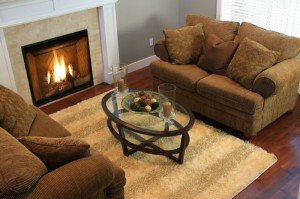You may have the right stuff, but do you know how to burn the right way? Keep reading to find out what in the world we’re talking about. Keep in mind, of course (for those that need to be told fast-food coffee is hot), that the following information applies only to wood-burning fireplaces.
Burning the right stuff. You need to have wood that is dry and seasoned, otherwise you’ll be choking on smoke—and not the fun kind. Green wood hasn’t had a chance to dry out yet. Any kind of moisture makes it harder for the fire have complete combustion, which is a fancy way of saying it won’t burn right and smoke will get into your eyes. The EPA advises that wood should be seasoned at least 6 months. Hardwoods, such as oak, ash or hickory, are great for getting the most out of your fire. They burn longer than soft woods, though you’ll probably need a soft wood (like pine or cedar) for kindling, since it’s easier to light. Hardwoods like to make you work for your reward.
Make the season right. And now for a brief lecture: The Chimney Safety Institute of America (CSIA) reminds us to have our chimneys inspected and cleaned annually. If you didn’t get it done during the spring, now’s the time. That way you’ll be sure that your chimney is safe to use and functioning properly.
Now that you’ve got the right stuff and your chimney is ready to roll, let’s light a fire!

Pick the right kind of wood. Build it in such a way that it produces maximum heat. Now, kick back and enjoy.
- Open the damper and deal with your drafts. Closed damper + fire = smoky house. Also, if you notice a draft when you go to open the damper, you’ll need to do a little troubleshooting. A draft coming down the chimney means you’ve got a little issue with negative air pressure. Check all the appliances around your home that use air. This can range from an exhaust fan or clothes dryer to a shower or flushing toilet. If you turn off anything you can think of and still have a draft, try opening a window or door.
- 2. Firestarter. Once you’ve determined that you don’t have a draft, it’s time to build the fire. Balled up newspaper often serves as a great firestarter. We don’t really recommend things like Duraflame logs, because they cause faster creosote buildup.
- 3. Kindling. Take your soft wood kindling and start layering the pieces in criss-cross formation over the firestarter.
- 4. Fire. Light the firestarter at the top—this will give it more time to catch the kindling on fire.
- 5. Wood. Once you’ve got a nice little kindling fire, start adding some small logs, being careful not to smother the fire. You might need to stoke the fire or lift one of your logs with a poker if you notice.
Now enjoy! And don’t forget, if you’re in the Indy area, Mad Hatter is here for you when it comes to any of your chimney needs. We’re just a phone call away.
